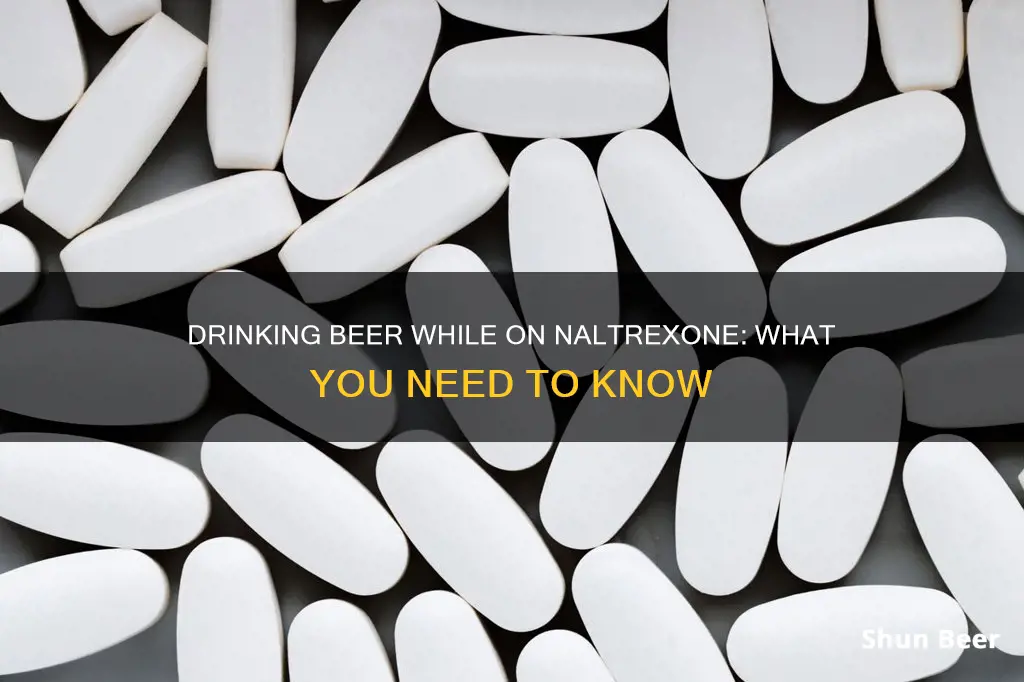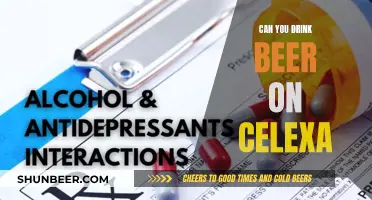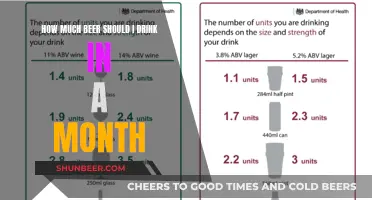
Naltrexone is a medication used to treat alcohol use disorder (AUD) and opioid use disorder (OUD). It works by blocking the euphoric effects and feelings of intoxication from alcohol and opioids, helping to reduce cravings and decrease consumption. While on naltrexone, individuals can still drink alcohol, but the buzz or reward associated with drinking is diminished, making it less enjoyable. This can help individuals with AUD to reduce their drinking behaviours and maintain sobriety. However, it is important to note that naltrexone does not prevent impairment while drinking alcohol, and individuals should refrain from activities such as driving or operating heavy machinery while under the influence.
| Characteristics | Values |
|---|---|
| Effect on "buzz" from alcohol | Naltrexone blocks the "buzz" or euphoric effects of alcohol |
| Effect on impairment from alcohol | Naltrexone does not prevent impairment, reduced coordination, poor judgment, or hangovers from drinking alcohol |
| Effect on cravings | Naltrexone reduces cravings for alcohol |
| Dosage | Naltrexone is usually taken as a tablet or as a monthly injection. The tablet is sold as ReVia or generically and is taken once daily or one hour before drinking. The injection is called Vivitrol and is taken once per month. |
| Side effects | Naltrexone may cause nausea, headaches, dizziness, anxiety, fatigue, and trouble sleeping. |
| Safety | Naltrexone is not recommended for those under 18 years old or those with other health conditions. It should not be used to enable driving or performing other activities under the influence of alcohol. |
What You'll Learn

Naltrexone blocks the 'buzz' from beer
Naltrexone is a medication that can help people with alcohol use disorder reduce their drinking. It does this by blocking the "buzz" or euphoric effects of alcohol, helping people to “unlearn” addictive drinking behaviour.
Naltrexone is a pure opiate antagonist and blocks opiate receptors in the body. It binds to the endorphin receptors in the body, and blocks the effects and feelings of alcohol. This means that people taking naltrexone can still drink alcohol, but they won't experience the same "high" or "reward" from intoxication.
For some people, this can reduce their cravings for alcohol, as the "reward" they usually get from drinking is diminished. One patient commented that the first time they drank on naltrexone, they poured half their glass of wine down the sink as it was so uninteresting.
Naltrexone is available as a daily pill or a monthly injection and is typically taken as part of a broader treatment plan that includes recovery coaching and counselling. It is important to note that naltrexone will not prevent impairment while drinking alcohol, so people should not use machinery, drive, or perform other activities while under the influence of alcohol when taking naltrexone.
Booster and Beer: Is It Safe to Drink Alcohol?
You may want to see also

Naltrexone is not a cure for alcohol use disorder
Naltrexone is a medication that can help people with alcohol use disorder (AUD) to reduce their drinking. It is not a cure for AUD, and it is important to understand the limitations of this treatment.
Firstly, naltrexone is not a stand-alone cure for AUD. It is intended to be used as part of a comprehensive treatment plan that includes counselling and other behavioural health therapies. This medication can help to reduce cravings and lessen the enjoyment derived from drinking, but it does not address the underlying causes of alcohol misuse. It is crucial for individuals to receive support and guidance to develop healthy habits and coping mechanisms. Without addressing the root causes of the disorder, the desire to drink may return.
Secondly, naltrexone does not prevent impairment from drinking. While it blocks the euphoric effects and feelings of intoxication from alcohol, it does not eliminate the physical effects of alcohol, such as reduced coordination, impaired judgment, and hangovers. Therefore, it is important to refrain from activities such as driving or operating heavy machinery while under the influence of alcohol, even when taking naltrexone. The medication does not provide a licence to drink without consequences.
Thirdly, naltrexone may not work for everyone. Some individuals may experience side effects such as nausea, headaches, fatigue, and trouble sleeping. In rare cases, naltrexone can cause mood changes and anhedonia, or a lack of overall pleasure, which can lead to depressive symptoms. It is important to consult with a medical professional and carefully consider the potential benefits and risks before starting naltrexone treatment.
Finally, naltrexone is not a quick fix. It is typically taken as part of a long-term treatment plan, and the effectiveness of the medication depends on consistent and proper usage. For some individuals, it may take time for the medication to completely eliminate alcohol cravings. Additionally, naltrexone should not be used as a substitute for abstinence during the initial stages of treatment. It is recommended that patients achieve a period of alcohol detoxification or abstinence before starting naltrexone treatment to avoid strong side effects and increase the medication's effectiveness.
Neoprene Beer Coolers: How Do They Work?
You may want to see also

Naltrexone does not prevent impairment while drinking alcohol
Naltrexone is a medication that can be used to treat alcohol use disorder. It is available in pill form or as a monthly injection. Naltrexone works by blocking the euphoric effects and feelings of intoxication from alcohol, often described as the "buzz". By reducing the pleasurable effects of alcohol, naltrexone can help individuals with alcohol use disorder decrease their cravings and drinking behaviours over time.
However, it is important to note that naltrexone does not prevent impairment while drinking alcohol. Even though individuals may not feel drunk or experience the usual "buzz", their coordination, reflexes, and judgement may still be impaired. This can make activities such as driving or operating heavy machinery dangerous. Naltrexone may also cause side effects such as dizziness and drowsiness, which can further impair an individual's ability to perform certain tasks. Therefore, it is crucial not to use naltrexone as a means to engage in activities that require alertness and coordination while under the influence of alcohol.
The effects of naltrexone on alcohol consumption are well-supported by research. Multiple studies have shown that daily naltrexone treatment or monthly injections can effectively reduce alcohol consumption in individuals with alcohol use disorder. Additionally, naltrexone has been found to block the craving for alcohol, helping individuals avoid drinking when they have an urge to drink. This can be particularly useful for individuals who struggle with cravings during recovery or wish to reduce their alcohol intake.
While naltrexone can be a helpful tool in managing alcohol consumption, it is important to understand its limitations. Naltrexone does not create a physical barrier to alcohol consumption, and individuals can still drink alcohol while taking naltrexone. However, the medication may reduce the enjoyment of alcohol, making drinking less appealing. This can help reinforce changes in drinking behaviours and gradually rewire the brain to not expect the same "buzz" from alcohol. Over time, with consistent use of naltrexone, individuals may find that their cravings decrease and they are better able to control their alcohol intake.
Beer and Milkshakes: Mixing Drinks, Safe or Not?
You may want to see also

Naltrexone is not a treatment for opioid use disorder
Naltrexone is a medication that can be used to treat alcohol use disorder (AUD) and opioid use disorder (OUD). It is not a treatment for opioid use disorder for several reasons. Firstly, naltrexone is not an opioid, and it does not cause withdrawal symptoms when an individual stops taking it. This means that it is not a substitute for opioids and does not provide any of the euphoric or intoxicating effects that opioids can induce. Instead, naltrexone blocks the euphoric and sedative effects of opioids, reducing cravings and suppressing the desire to use them. Therefore, it serves as a tool to aid in the treatment of opioid use disorder rather than a direct treatment itself.
Additionally, naltrexone is intended to be used as part of a comprehensive treatment plan that includes counselling and other behavioural health therapies. It is not meant to be taken in isolation to treat opioid use disorder. The medication is also not recommended for individuals under 18 years of age or those experiencing other health conditions.
Furthermore, there are specific guidelines that must be followed before initiating naltrexone treatment for opioid use disorder. Patients should refrain from using any opioids or illegal drugs, drinking alcohol, or consuming sedatives, tranquilizers, or other drugs during the treatment. They should also inform their practitioner about all medications they are currently taking and any changes in their medication regimen. To reduce the risk of withdrawal symptoms, patients should wait at least 7 days after their last use of short-acting opioids and 10 to 14 days for long-acting opioids before starting naltrexone.
In summary, while naltrexone is a valuable tool in the treatment of opioid use disorder, it is not a standalone treatment. It is intended to be used alongside other therapies and under the supervision of a licensed medical practitioner. Naltrexone helps reduce cravings and suppresses the rewarding effects of opioids, making it easier for individuals to manage their disorder.
Beer Drinking in Oklahoma: Sunday's Special Rule
You may want to see also

Naltrexone is not a substitute for counselling and behavioural therapy
Naltrexone is a prescription medication used to treat alcohol use disorder and opioid use disorder. It is not a substitute for counselling and behavioural therapy, and it should be used as part of a comprehensive treatment plan that includes these elements. Here's why:
Firstly, naltrexone is most effective when combined with counselling and behavioural therapy. Research suggests that naltrexone is more effective when taken as part of a holistic program that includes recovery coaching and counselling. This is because it is important to address the root causes of alcohol or drug use, develop healthy habits, and learn coping mechanisms to prevent relapse. Naltrexone can help reduce cravings and lessen the enjoyment of alcohol or drugs, but it does not address the underlying psychological factors that contribute to addiction.
Secondly, naltrexone does not prevent impairment from alcohol or drugs. While naltrexone blocks the euphoric effects and feelings of intoxication from alcohol or drugs, it does not prevent physical impairment, such as reduced coordination, reflexes, or poor judgment. This means that individuals taking naltrexone can still experience negative consequences from substance use, such as accidents, injuries, or impaired decision-making. Therefore, it is crucial to have counselling and behavioural therapy alongside naltrexone treatment to help individuals develop alternative coping strategies and make healthier choices.
Thirdly, naltrexone may have side effects that require monitoring and support. Common side effects of naltrexone include nausea, headaches, dizziness, anxiety, fatigue, and trouble sleeping. In rare cases, naltrexone can cause more severe side effects such as liver damage, severe allergic reactions, or changes in hormones. It is important for individuals taking naltrexone to have access to counselling and behavioural therapy to manage these side effects and receive additional support if needed.
Finally, naltrexone is not a cure for addiction and should not be relied upon as a standalone treatment. While naltrexone can be a helpful tool in managing alcohol or drug use, it is not a cure. It is intended to be used in conjunction with other forms of treatment, such as counselling and behavioural therapy, to give individuals the best chance of long-term recovery. Addiction is a complex disease, and a comprehensive treatment approach that addresses the biological, psychological, and social aspects of the disease is crucial for sustained recovery.
Beer and Blood Work: What's the Connection?
You may want to see also
Frequently asked questions
Yes, you can drink beer on naltrexone. However, naltrexone blocks the euphoric effects and feelings of intoxication from alcohol, so the "buzz" from drinking beer will be reduced.
Naltrexone is used to treat alcohol use disorder and opioid use disorder. It helps to reduce cravings and decrease consumption.
Naltrexone blocks the endorphin rush and euphoric effects of alcohol, helping to unlearn addictive drinking behaviour. It can be taken as a daily pill or a monthly injection.
Some people experience nausea, headaches, dizziness, anxiety, tiredness, and trouble sleeping when taking naltrexone. These side effects are usually mild and tend to go away after a couple of weeks.







